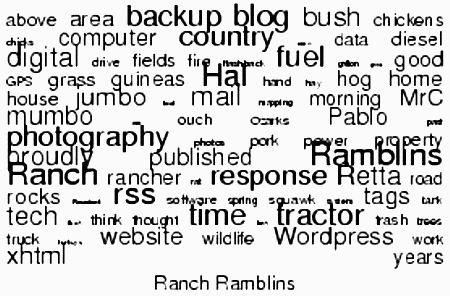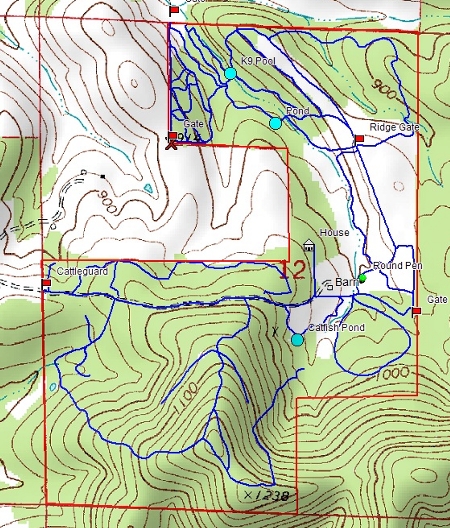In this day and age, when it sometimes seems as if the business community is out of touch with the customers upon whom they depend, it is refreshing to see one company respond quickly and politely to a customer’s concern over a potential problem. I am referring to the good people at snapshirts.com, who have earned my respect and praise for their response to my concerns, and more important, for their response to the blogging community at large.
Here is a little background. If you are a frequent visitor to blogs of any genre, you may remember a period of time earlier in the year when suddenly, it seemed as if every blog in existence posted an image of what is called a “word cloud”. The clouds that were posted on these blogs were primarily generated from the snapshirts.com website mentioned above. From comments on the blogs at the time, it became apparent that word clouds were very well accepted by bloggers and their readership. This generated a lot of traffic at snapshirts.com, who is in the business of selling products utilizing the word cloud concept.
Recently, one of the blogs that I regularly read indicated that there had been a marked increase in comment spam, and the author wondered what could have caused the sudden increase.  As I thought about this, for unknown reasons my mind flashed back to the word cloud I had seen on that site.  Could this be the culprit, I wondered?  By performing a search on “word cloud”, I was able to locate numerous blogs that had posted their own version of a word cloud. By than searching those blog’s archives for “spam”, it soon became apparent that many of those blogs had also experienced an increase in spam. Could the increase in comment spam have been caused by the submission of their URLs to the snapshirts.com site? I am not well versed in this type of thing. I can’t fathom why spam even exists in the first place, let alone figure out how it is accomplished. So I thought, “why not ask snapshirts.com directly?” Here is the correspondence that ensued:
On 5/2/06, Hal Mitzenmacher wrote:
There are many people in the blogging community who have noticed a marked increase in comment spam on their blogs since submitting their URLs to Snapshirts.  Is there more going on here than meets the eye?  If you were to perform a web search on snapshirts + spam, and then examine the result, you will see what I am referring to.  Would you please address this issue on your blog for those of us who may feel doubts about continuing the use of your services?
Thank you.
Â
Response from snapshirts.com:
Mr. Mitzenmacher,
First, I want to thank you. You have brought a flaw in our old fulfillment methodology to our attention. Upon receiving your message we immediately took what steps we could to rectify the situation. In the past, we had included the weblog URL on the T-shirt’s order page to ensure customers received the T-shirt that was directly linked to their blog. This inadvertently made those URLs available on the Internet for persons with malicious intent. We have subsequently updated our fulfillment technology to allow instant T-shirt generation and purchase, so we no longer publish any information beyond the image. After receiving your message yesterday and realized what had likely occurred, we immediately removed all pages from the Internet that were generated using our older methodology. Those pages are no longer accessible over the Internet.
Second, I assure you that I have NO direct affiliation with ‘sploggers’, comment spammers or spam providers of any sort. If you want to call, my cellphone number is xxx-xxx-xxxx and if I could afford a ticket to the Ozarks I’d fly out so you could look me in the eye on this one. Weblog producers are our sole customers and we are very sensitive to the highest standards of customer service that must be maintained in serving this community. We were taken advantage of but in no way did we collude with anyone to produce this unfortunate result.
Third, you mention other bloggers experiencing this effect and commenting on it. I searched the “snapshirts + spam” combination on Google, Google Blog Search, IceRocket, Bloglines and Technorati but was unable to find another blog post on this issue. If you are aware of other blog posts or bloggers with this issue I’d appreciate any link so that I can address this issue personally with them as well. Last, but most certainly not least, I want to apologize for any inconvenience this has caused you. I will be posting a notice on our blog today with this information and links to free tools and add-ons for various weblog systems which can be installed to combat comment spam. For wordpress, I use Spam Karma, which has a 100% record on my personal blog for catching comment spam and permitting actual comments.
Sincerely,
Jonah Keegan
snapshirts.com
Â
My reply to snapshirts.com:
Mr. Keegan,Â
As I read the original email that I submitted to you, specifically,Â
“There are many people in the blogging community who have noticed a marked increase in comment spam on their blogs since submitting their URLs to Snapshirts” …Â
I can see that I might have been a little vague regarding other bloggers experiences. I did not mean to imply by this statement that other bloggers necessarily made a connection between the increase in spam they were experiencing and the submitting of their URLs to Snapshirts. I am the one who made this connection when, while visiting many differing types of blogs on a regular basis, I began to notice a pattern. There was a short period of time when it seemed as if every blogger in cyberspace was posting their own word clouds. Here is a comment I made on one blog’s Word Cloud post:
“A Google search of “word cloud†now produces over 11,200,000 hits, mostly from bloggers! I wonder how many t-shirts Snapshirt will sell? And how long before a Wordpress “Word Cloud†plugin appears?”Â
Shortly thereafter, many of these same blogs began reporting an increase (sometimes dramatic) in the volume of comment spam they received. This can probably best be seen by using the same methodology as I did. Perform a search to find blogs that posted their word clouds, and then, from within each individual blog, perform a blog search of posts pertaining to comment spam. When I saw the results obtained with this methodology, my suspicions became aroused. Whether there is a cause-and-effect relationship, I don’t know, as I know little about comment spam (other than the fact that it is obnoxious and annoying). It might well be that this same methodology would yield statistically identical results by searching these very same blogs for “sun spots”, for example. I just do not know. Which is exactly why I contacted you to inform you of my suspicions.
The tone and speed of your reply indicates your sincerity about this issue. No need for you to travel out to the Ozarks so I can “look you in the eye”, however, should you ever get the chance, I’m certain you would find the area a delightful place to visit.
Hal Mitzenmacher
Â
Snapshirts.com response:
Thank you. I can tell you our sales are far less than 11.2 million, wouldn’t that be something… :) We are very grateful to the blogging community however, for providing us such a uniformly positive reception and sending us a steady stream of visitors.
I can also tell you we are working to develop a free word cloud plugin for wordpress or any blog, with some features we hope will appeal to bloggers as much as our t-shirts do.
Thanks again for bringing this to my attention.
Sincerely,
Jonah Keegan
Â
I have checked the snapshirts.com website today and I have found that they have, indeed been hard at work addressing this issue (see post here). And as a showing of confidence, here is the word cloud that I have just produced from the snapshirts.com website:






